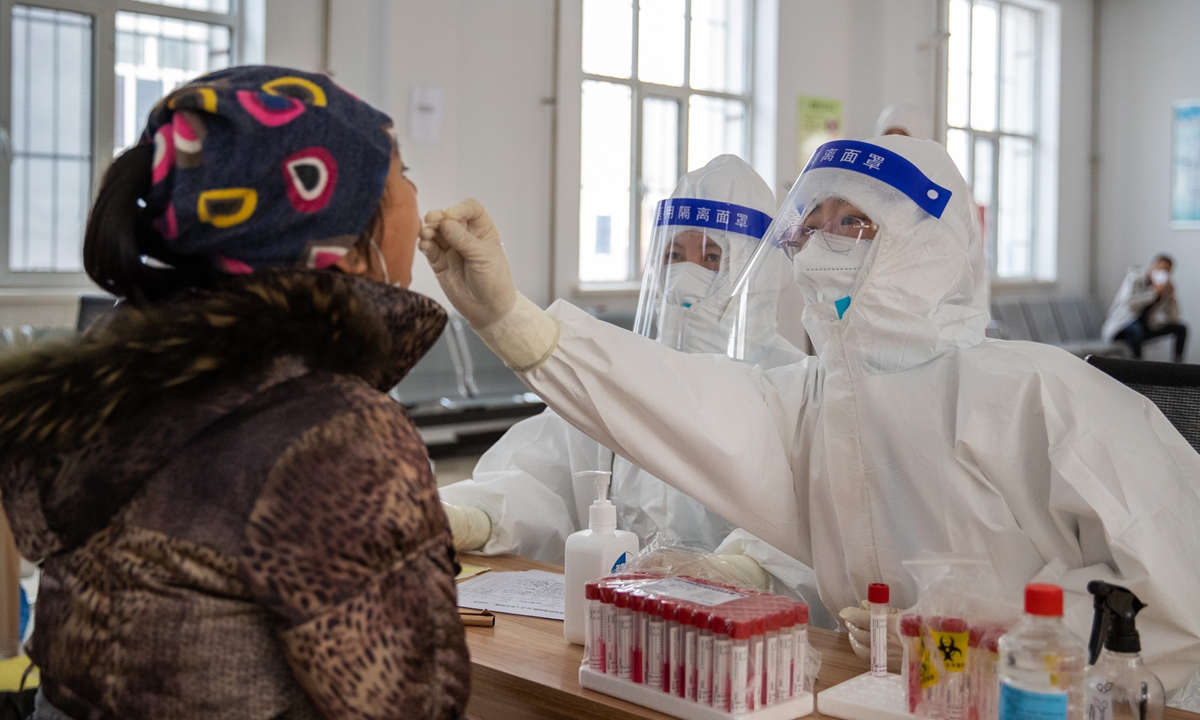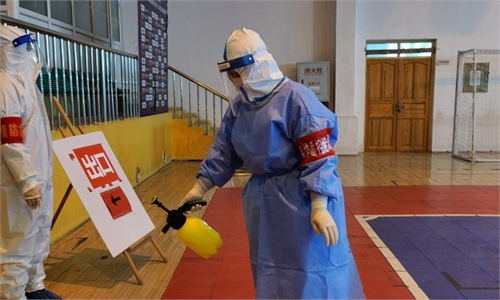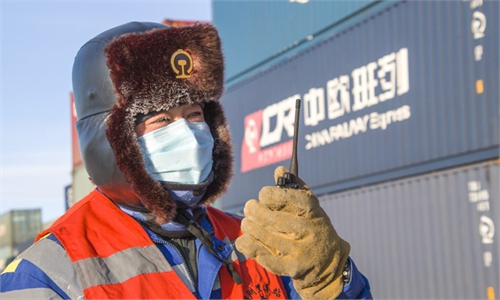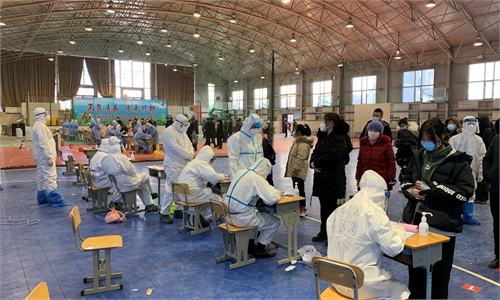Manzhouli port hit by imported virus, 'to be contained within 14 days'
Loopholes in ports in both China and neighboring countries challenge dynamic zero tolerance

A resident of Manzhouli, a land port city in North China's Inner Mongolia Autonomous Region, takes a nucleic acid testing on November 28, 2021. The city reported 19 locally transmitted COVID-19 cases and 60 samples that were positive for coronavirus. Photo: VCG
Manzhouli, China's largest land port city in North China's Inner Mongolia Autonomous Region, is in the spotlight as the latest coronavirus flare-up has seen 142 new infections as of Wednesday, which was caused by contaminated imported goods. As a city bordering Mongolia and Russia where many China-Europe freight trains passing through every year, Manzhouli, like some other Chinese port cities, has been standing at the frontline in fighting against imported virus cases. Epidemiologists and insiders warned that loopholes in port management challenge China's dynamic zero-COVID policy.Local authorities are confident they will contain the outbreak within 14 days, as China's dynamic zero-COVID policy boosted the confidence and experts believed the approach remains the most effective one amid rising uncertainties of the epidemic worldwide.
The city of a population of 300,000 reported 12 new cases on Wednesday and raised the status of three neighborhoods to high-risk after Manzhouli completed its third round of citywide nucleic acid testing. It is not the first time this land port city has had to confront coronavirus flare-ups caused by imported cases, after Manzhouli port found imported cases from Russia in April 2020 and then fought a domestic outbreak in late November 2020 due to imported virus.
The latest flares-up came about a month after another border city in the region, Ejin Banner, was hit by a imported source in mid-October. Although the source remains unclear then, epidemiologists close to the National Health Commission believe the virus was likely imported through ports from Mongolia, highlighting the challenges that Chinese ports are facing as the global epidemic has yet to be tamed.
The full genomic sequence of the first three confirmed COVID-19 cases in Manzhouli has a low homology with previous domestic outbreaks, which means this round was caused by a new imported source, according to a briefing by local authorities on Tuesday night.
Starting Wednesday, Manzhouli railway port suspended the import of non-container goods including wood, coal, mineral powder, chemical fertilizer, pulp, non-gold mined goods, agricultural and other goods that require manual loading and unloading.
Growing challenges
Wang Guangfa, a respiratory expert at Peking University First Hospital, told the Global Times on Wednesday that the virus tends to stay longer on surface of goods which could increase the possibility of high-risk people being infected if they fail to maintain good hygiene in daily life.
"When epidemic is still rampant overseas, port workers not only need to go through frequent nucleic acid tests, but also need to be alert over their daily hygiene," he said.
Russia and Mongolia were the two largest trading partners at Manzhouli port from January to October, according to customs data. Total imports and exports from and to Mongolia increased 82.4 percent year-on-year in the first 10 months of 2021, reaching 1.6 billion yuan ($251.2 million).
Among the first three infections in the new flare-up, two work loading and unloading freight and the third one is a wood processing staff member in logistics firm which handles international freight, according to media reports. The firm also organized the first China-Europe freight train departed from Manzhouli, shipping wood to overseas markets like Russia.
Although it is unclear where the imported virus came from, local traders reached by the Global Times said on Wednesday that Manzhouli's growing cross-border freight services increased the risk of carrying the virus via freight trains.
"Recently, the freight capacity of China-Europe train has been very tight, and some goods that used to be transported through other rail ports or goods transported by trucks were transported by train via Manzhouli port," a transportation agent surnamed Yu for goods transported from China to Russia through Manzhouli, told the Global Times on Wednesday.
Manzhouli was one of the fastest customs clearance ports among all the China-Europe freight train routes linking China and Russia, he said.
Frequent freight services and regular cross-border cargo and people exchanges are considered to be potential transmission channel for infectious diseases, given that the epidemic situation in Mongolia and Russia remains severe.
Although Mongolia has taken strict prevention measures, there may be some loopholes at its ports due to less thorough disinfection or malpractice of some working staff which means not all products had been properly disinfected or that nucleic acid tests are not accurate, some observers said.
According to the agreement between China and Mongolia, personnel, products and means of transportations can go through the ports. Since the outbreak of the COVID-19 pandemic, some ports had temporarily halted trade. But last year, the two countries agreed to open green channels for trade.
To stabilize China-Mongolia trade, the two countries launched a special channel last year to ensure the necessary people and product exchange and Mongolia established an epidemic prevention mechanism. It enhanced epidemic prevention at ports in November 2020 with strict disinfection procedures and nucleic acid testing among port staff.
To fix loopholes
While the world is now facing new challenges as the Omicron variant has seen more Western countries close their borders, China's dynamic zero-COVID policy has proven the most effective in containing and quashing outbreaks.
Manzhouli has conducted mass nucleic acid testing, timely epidemiologist investigation and source tracing while tracking close contacts as well as sealing off residential compounds, Xu Hongzhi, Party chief of the health commission in Inner Mongolia, was quoted as saying in media reports on Wednesday. Xu said the city was confident the outbreak would be contained within 14 days,
Such confidence derives from a yearlong practice of China's dynamic zero-COVID policy, experts said.
"This strategy curbs the epidemic at the early stage and prevents it from spreading. It ensures the majority of places in China won't be affected by a resurgence," Wu Zunyou, Chief Epidemiologist at the Chinese Center for Disease Control and Prevention (CDC) said during a recent event held by Caijing magazine.
The zero-COVID strategy is China's magic weapon in containing the epidemic, Wu said, noting that the source of infection of COVID-19 is either from people returning to China from overseas or from imported goods.
Still, the resurgence in Manzhouli serves as a reminder that some loopholes continue to exist in implementing the zero-tolerance policy, an anonymous source close to the National Health Commission told the Global Times on Wednesday.
"Although China's dynamic zero-case policy gives us an edge in responding to the epidemic, it's worth finding out where the loopholes are in carrying out the policy," he said.





